Click on an image below to see a larger version. Right click on an image and choose “Save image as…” to use it in your digital interactive.
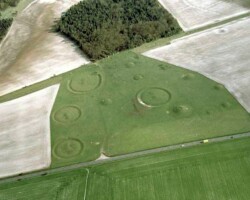
Oakley Down, Wimborne St Giles, Dorset
An aerial view of a Bronze Age barrow cemetery on Oakley Down. Barrows are mounds of earth or stone constructed over prehistoric tombs.
Photograph taken March 1990 © Crown copyright. Historic England Archive ref: nmr 4503/29
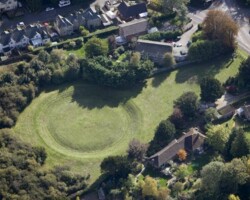
Flowerdown Barrows, Littleton, Hampshire
This is one of three Bronze Age barrows, known as Flowerdown Barrows. There is a disc barrow and two bowl barrows. This is the disc barrow. It is 28 metres in diameter and has two circular mounds within it. The central mound is seven metres in diameter and has a central hollow. The second lies to the southwest of the centre and is six metres in diameter. It has been described as the largest and finest barrow of its kind in Hampshire. Barrows such as this were Bronze Age tombs where one or more people were buried within the barrow. This group of three barrows are thought to be what remains of a larger ‘barrow cemetery’, the other having since been destroyed. This site is now in the care of English Heritage (2010).
© Historic England Archive Photo Library ref: N090554
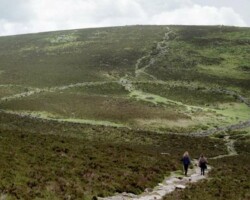
Grimspound Prehistoric Settlement, nr Manaton, Devon
Grimspound consists of the remains of a partly enclosed stone hut circle settlement and field system dating from the late Bronze Age. It is situated in a fold of hills between Hookney Tor and Hameldon at a height of 1500 ft on the eastern side of Dartmoor. The enclosure comprises an earth and stone wall surrounding an area containing at least 24 stone hut circles. The site has undergone reconstruction since it was first recorded in 1797, though not always accurately. In 1894, 16 of the hut circles were partly excavated and numerous structures and artefacts were uncovered. These included porches, paved floors, 'hearths', 'raised benches', pottery, `anvil stones', flints and cooking stones. There was further restoration work in the 1960s, under the direction of Lady Fox, and in 1991 an RCHME (Royal Commission on the Historical Monuments of England) survey was carried out on the site. The site is now in the care of English Heritage (2010).
© Crown copyright.NMR ref: AA008409

Grimspound Prehistoric Settlement, nr Manaton, Devon
This is a reconstruction drawing of what Grimspound Prehistoric Settlement might have looked like. Grimspound consists of the remains of a partly enclosed stone hut circle settlement and field system dating from the late Bronze Age. It is situated in a fold of hills between Hookney Tor and Hameldon at a height of 1500 ft on the eastern side of Dartmoor. The enclosure comprises an earth and stone wall surrounding an area containing at least 24 stone hut circles. The site has undergone reconstruction since it was first recorded in 1797, though not always accurately. In 1894, 16 of the hut circles were partly excavated and numerous structures and artefacts were uncovered. These included porches, paved floors, 'hearths', 'raised benches', pottery, `anvil stones', flints and cooking stones. There was further restoration work in the 1960s, under the direction of Lady Fox, and in 1991 an RCHME (Royal Commission on the Historical Monuments of England) survey was carried out on the site. The site is now in the care of English Heritage (2010).
© Ivan Lapper. Source Historic England Archive Photo Library ref: J940467

Grimspound Prehistoric Settlement, nr Manaton, Devon
Grimspound consists of the remains of a partly enclosed stone hut circle settlement and field system dating from the late Bronze Age. It is situated in a fold of hills between Hookney Tor and Hameldon at a height of 1500 ft on the eastern side of Dartmoor. The enclosure comprises an earth and stone wall surrounding an area containing at least 24 stone hut circles. This is reconstruction drawing of what life inside the hut circles might have been like. The site itself has undergone reconstruction since it was first recorded in 1797, though not always accurately. In 1894, 16 of the hut circles were partly excavated and numerous structures and artefacts were uncovered. These included porches, paved floors, 'hearths', 'raised benches', pottery, `anvil stones', flints and cooking stones. There was further restoration work in the 1960s, under the direction of Lady Fox, and in 1991 an RCHME (Royal Commission on the Historical Monuments of England) survey was carried out on the site. The site is now in the care of English Heritage (2010).
© Ivan Lapper. Source Historic England Archive Photo Library ref: J940469
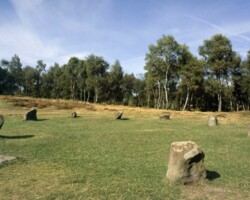
Nine Ladies Stone Circle, nr Stanton in Peak, Derbyshire
A small early Bronze Age stone circle traditionally believed to depict nine ladies turned to stone as a penalty for dancing on Sunday. It is part of a complex of prehistoric circles and standing stones on Stanton Moor. There is also a single standing stone known as the King's Stone to the southwest of the circle. This site is now in the care of English Heritage (2010).
© Historic England Archive Photo Library ref: K031048
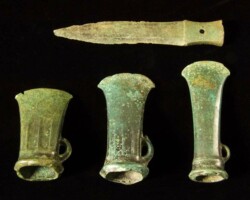
Bronze Age Objects, Beeston Castle, Beeston, Cheshire
Bronze Age objects found at Beeston Castle, including axe heads and a knife. Beeston Castle is located on a rocky crag above the Cheshire plain. The site has been occupied since prehistoric times and excavations have revealed remains spanning the Neolithic, Bronze Age, Iron Age and Roman periods. Beeston Castle itself was begun in the 1220s by Ranulf de Blundeville, the Sixth Earl of Chester. These objects are now in the care of English Heritage (2011).
Photograph taken 2007 © Historic England Archive Photo Library ref: N071034

Bronze Age Huts, Brean Down, Somerset
A reconstruction drawing of Bronze Age huts on Brean Down. Excavations here revealed the presence of an Early to Middle Bronze Age settlement. The site consisted of a midden (rubbish pit), general domestic waste such as pottery, hearths and two huts. There was also evidence for bone and leather working and small scale salt production. Possible field systems next to the huts were examined but provided little evidence for farming crops, it is thought they may have be used as animal enclosures.
Photograph taken 1989 © Peter Dunn. Source Historic England Archive Photo Library ref: J890031
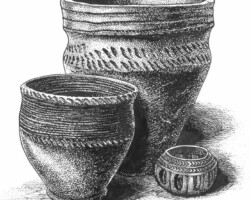
Reconstruction Drawing of Bronze Age Pottery
Reconstruction drawing of a Bronze Age (2600-700BC) food vessel (left), Collared Urn (centre) and incense pot (right). The food vessel would have been used for cooking. Collared Urns were used for cremations. After death people were cremated (burnt) and their ashes were placed in the large urn, which was then buried (often upside down) in the ground. The small pot may have been used for burning incense.
Photograph taken 1998 © Peter Dunn. Source Historic England Archive Photo Library ref: N980005
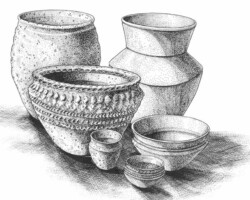
Reconstruction Drawing of Late Bronze Age Pottery
Reconstruction drawing of Late Bronze Age (1200-700BC) pots. This type of pottery would have been used for cooking with and eating from.
Photograph taken 1998 © Peter Dunn. Source Historic England Archive Photo Library ref: N980006
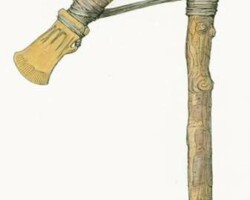
Bronze Age axe, Beeston Castle, Beeston, Cheshire
Reconstruction drawing showing how a Bronze Age axe blade excavated at Beeston Castle may have been attached to a wooden handle to form an axe.
Photograph taken 2007 © Judith Dobie. Source Historic England Archive Graphics Team ref: ic009_008
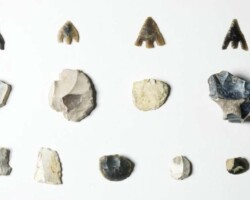
Early Bronze Age Tool Kit
This collection of flints shows the range of stone tools used by people during the Early Bronze Age. It includes 'barbed and tanged' arrowheads on the top row; a piercer on the left of the middle row; side scrapers in the centre of the middle row; a core on the right of the middle row; edge-trimmed knives on the left of the bottom row and thumbnail scrapers on the right of the bottom row. Arrowheads were attached to wooden shafts to make arrows for hunting. Piercers were used for making small holes in things such as wood, bone or leather. Scrapers were used for cleaning animal skins in the process of making leather. A core was the raw material from which other tools could be made. Knives were attached to wooden handles and used for cutting like knives today.
Photograph taken 2009 © Historic England Archive ref: DP081194
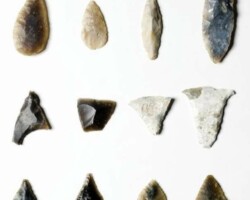
Stone Age and Bronze Age Types of Arrowhead
The Stone Age itself is split by archaeologists into 3 stages.The Early Stone Age, known as the Palaeolithic, the Middle Stone Age, known as the Mesolithic and the New Stone Age, known as the Neolithic. The names all use the Latin for stone, which is lithic and then palaeo means old, meso means middle and neo means new. The arrowheads on the top row date from the Early Neolithic and are often known as 'leaf-shaped' arrowheads. Those on the middle row date from the Late Neolithic (the time of Stonehenge). The one the left is an 'oblique' arrowhead, the other 3 are called 'transverse' arrowheads. Those on the bottom row date from the Early Bronze Age and are known as 'barbed and tanged' arrowheads - the 'barbs' being the bits sticking out at either side and the 'tang' being the bit in the middle.
Photograph taken 2009 © Historic England Archive ref: DP081199

